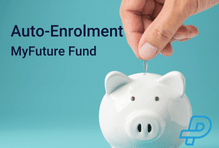Auto-enrolment is a government-led program that automatically enrols eligible employees into a workplace pension scheme, ensuring they save for retirement. Employees contribute to the scheme, and their employers match these contributions, with the government providing additional top-ups.
The new scheme, called MyFuture Fund, will launch in September 2025.
The government aims to simplify the retirement savings process and increase participation rates, especially among those who might not take the initiative to join a pension plan.
A new independent body, the National Automatic Enrolment Retirement Savings Authority (NAERSA), set up by the Department of Social Protection, will manage auto-enrolment.
In October 2024, the government signed a contract with Indian company Tata Consultancy Services (TCS) to provide administration services for the new pension auto-enrolment (AE) system. TCS operates in Ireland in Letterkenny and Dublin and offers similar services in other countries, including the UK.
The Pensions Authority will supervise the auto-enrolment scheme. It will function with statutory independence and a Board of Directors will govern it.
Key Features of the Pension Auto-Enrolment in Ireland Scheme
Eligibility:
- Employees aged 23 to 60.
- Earning over €20,000 annually. (Including bonus, tips, share options, benefits in kinds)
- Not already enrolled in a pension scheme.
Contributions:
- Employees will contribute a percentage of their gross earnings to the pension scheme.
- Employers will match this contribution.
- The government will add an additional top-up amount to incentivize saving.
Gross Earnings Can Include:
- Salary
- Wages
- Tips declared via payroll
- Benefits in kind – company car etc
- Bonuses
- Shares (recently required to be declared via payroll)
Maximum Contributions:
- The maximum contribution rate will reach 6% of an employee’s gross earnings for both the employer and employee after a phased introduction.
- The government will contribute an additional 2% of the employee’s gross earnings, bringing the total contribution to 14%.
- Contribution limits may apply to earnings above a certain threshold to ensure affordability and sustainability for businesses and workers.
Phased Contribution Table
| Year | Employee Contribution (%) | Employer Contribution (%) | Government Contribution (%) | Total Contribution (%) |
|---|---|---|---|---|
| 1-3 | 1.5% | 1.5% | 0.5% | 3.5% |
| 4-6 | 3% | 3% | 1% | 7% |
| 7-9 | 4.5% | 4.5% | 1.5% | 10.5% |
| 10+ | 6% | 6% | 2% | 14% |
Opt-Out Option
Employees can opt out after a mandatory six-month participation period. Re-enrolment will occur biannually unless they choose an alternative pension arrangement.
Potential Tax Implications for Higher Earners
While the pension auto-enrolment scheme benefits most employees, higher earners may face tax implications:
- Contribution Caps: Tax relief applies only up to certain income thresholds. Employees earning above this cap may not receive the same level of tax benefits on additional contributions.
- Marginal Tax Rate: Higher earners may experience limited tax savings relative to their total contributions, reducing the overall incentive to save within the scheme.
- Balancing Contributions: Employees in higher income brackets should consult a financial advisor to determine the best mix of pension savings and other investment strategies.
Employers should prepare to address these concerns and provide clear information to affected employees.
Timeline for Auto-Enrolment / My Future Fund at Parolla
Tata Consultancy Services (TCS) is developing a test environment for payroll software providers. The Payroll Software Developers Association (PSDA) has not received a timeline for its availability. Since January, Parolla has attended twice-weekly meetings with all current stakeholders as a PSDA member. Once the test environment becomes available, each software provider must update and test their systems. This process typically takes six months to a year.
The minister signed the commencement order, meaning the first enrolments under the My Future Fund scheme should begin on September 30, 2025. It remains unclear whether this date marks the beginning of employee sign-ups or the start of contributions.
The National Automatic Enrolment Retirement Savings Authority (NAERSA) will be established in March 2025.
On March 12, 2025, the Department of Social Protection invited companies interested in managing AE workplace funds to tender for the business. The department seeks three investment managers, each offering fund options of low, medium, and high risk. Investment managers must submit their pitches by April 7, 2025.
Potential Challenges
Despite its benefits, auto-enrolment presents challenges:
- Affordability for Employers: Small businesses may struggle to match employee contributions.
- Employee Engagement: Encouraging employees to understand auto-enrolment’s value and discouraging them from opting out is essential.
- Implementation Complexity: Nationwide rollout requires significant administrative effort and investment.
A Positive Step Forward
Auto-enrolment marks a significant policy shift, ensuring that everyone has the opportunity to save for a secure and dignified retirement. By introducing this process and offering financial incentives, Ireland aligns with countries like the UK and New Zealand, where auto-enrolment has successfully increased pension coverage.
Though implementation may pose challenges, the long-term benefits for individuals and society outweigh the hurdles.
